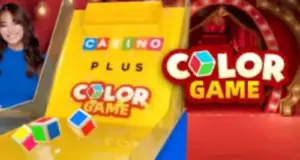Discover the Mechanics of the Filipino “Color Game” 🇵🇭
The Color Game is a vibrant, traditional Filipino pastime often seen at fiestas and local events. Whether you’ve encountered it at a carnival or watched players around a colorful board, the Color Game is a game of pure chance, where the outcome is determined by the roll of the dice.
In this educational guide, we break down the core mechanics of the Color Game, the dice rolls, betting odds, and payout structure, while exploring the concepts of RTP (Return to Player) and volatility in this exciting game of luck.
Important Note: This guide is purely for educational purposes. iGamingPH.com is not a gambling platform and does not promote or facilitate gambling. Always play responsibly and understand the inherent risks involved in online gaming. For responsible gaming resources, visit our Responsible Gaming Advice page.

Uncover the Mechanics of the Filipino “Color Game”: An Educational Guide 🇵🇭
Table of Contents
ToggleIntroduction: What is the Color Game? 🤔
The Color Game is a popular Filipino game of chance, commonly found at fiestas, carnivals, and local celebrations across the Philippines. Players place bets on different colors, and the outcome is determined by the roll of the dice, which are imprinted with various colors.
Though simple, the Color Game offers a deep dive into random chance, making it both a community experience and an exciting way to test luck. This guide will help you understand the mechanics behind it, offering clarity on how the game works and the odds that govern it.
The Core Mechanics: How the Color Game Works 🎲
The Color Game revolves around randomness and luck. Unlike digital slot machines, this game uses physical dice and tangible components to determine outcomes. The simplicity of the game makes it highly accessible, while its reliance on chance ensures an exciting experience for players.
The Components of the Color Game 🎨
To understand how the Color Game works, let’s look at its key components:
- The Board: The game board typically consists of multiple color zones (e.g., Red ❤️, Blue 💙, Green 💚, Yellow 💛, Orange 🧡, Purple 💜). Each zone has a designated betting area.
- The Dice: Usually, 3 dice (sometimes 2) are used in the Color Game. Each die face is marked with a specific color that corresponds to one of the betting areas on the board.
- The Shaker: A cup or container used to shake and roll the dice, ensuring that the results are random and unbiased.
The Betting Process 💰
Participating in the Color Game is straightforward:
- Place Your Bet: Players place their chips or cash on one or more colors on the board. You can choose to bet on one color or multiple colors, depending on your strategy.
- Dice Roll: Once all bets are placed, the game master (or “banker”) shakes the dice in the shaker, creating suspense, before rolling them onto the board.
- Outcome Reveal: The game master reveals the outcome by showing which colors are face-up, and the payouts are distributed based on the dice results.
The Element of Randomness: Dice Rolls ✨
The core of the Color Game is randomness. The dice are carefully designed to be balanced, ensuring that each face has an equal chance of landing face-up. Every dice roll is an independent event, and the outcome is purely determined by chance.
There are no algorithms or hidden mechanics—just pure, unadulterated randomness. This makes the game exciting and fair, as each roll of the dice is equally unpredictable.
Understanding Payouts: The Color Game Odds 💵
The Color Game’s payout system is simple and transparent:
Basic Payout Structure 📊
- Single Hit: If one of the dice shows your chosen color, you win 1:1 (you get your bet back plus an equal amount).
- Double Hit: If two dice show your chosen color, you win 2:1 (you get your bet back plus twice that amount).
- Triple Hit: If all three dice show your chosen color, you win 3:1 or higher (you get your bet back plus three or more times that amount).
The more dice that match your color, the higher the payout!
Determining Winning Outcomes ✅
Once the dice are rolled, the game master identifies the face-up colors. Players who placed bets on the winning colors are paid according to the number of dice that landed on those colors. For example, if you bet on Red and two dice show Red, you win the double hit payout for Red.
This process is transparent, direct, and easy for players to follow.
The Statistical Side: RTP and Volatility in Color Game 📉
Though the Color Game is a traditional game of chance, it can be analyzed using concepts from digital gambling like RTP and volatility.
Return to Player (RTP): The Long-Term Expectation 📈
The RTP for Color Game depends on the probabilities of the dice landing on your chosen color(s). The RTP reflects the theoretical long-term percentage of money returned to players over time.
For example, if you bet on a single color, there’s a mathematical probability that one, two, or all three dice will show that color. The game’s payout odds are typically set slightly lower than the true odds, which creates a house edge. Over time, this results in an RTP that is typically less than 100%, meaning the house will retain a small percentage of all wagers.
Volatility: Understanding Risk and Reward 🎢
Volatility refers to the frequency and size of payouts. Understanding volatility helps you decide how much risk you want to take.
- Lower Volatility: Betting on one color (hoping for a single hit) is low risk, but the payouts are smaller and more frequent.
- Higher Volatility: Betting on a triple hit (three dice showing the same color) has higher risk but offers larger payouts.
By understanding volatility, you can tailor your bets based on how often and how much you want to win.
Playing the Color Game: Your Interaction 🖐️
The Color Game is a hands-on, engaging experience, emphasizing direct interaction with the game’s components:
Simple Game Controls 👍
- Placing Bets: Players physically place chips or cash on the designated areas of the board.
- Observing the Roll: Watch as the game master shakes and rolls the dice to determine the outcome.
- Claiming Wins: If your chosen color appears, collect your payout from the game master.
There are no complex interfaces, digital controls, or autoplay functions—just pure, traditional gaming!
Conclusion: Chance and Enjoyment 💡
The Color Game is an exciting traditional Filipino pastime where pure chance dictates the outcome. With simple mechanics, transparent payouts, and the element of surprise, it offers a straightforward yet thrilling experience.
By understanding the RTP, volatility, and betting structure, you can engage with the game more effectively. Whether you’re playing for fun at a fiesta or exploring its mathematical components, the Color Game remains a beloved part of Filipino culture.
Remember, the Color Game is based purely on chance. This guide is offered for educational understanding only and is unequivocally not intended to promote gambling. Your informed understanding remains your most potent tool! For all our essential guidelines and policies, please refer to our Affiliate Disclosure, Disclaimer, Privacy Policy, FAQ, and Your Money Your Life (YMYL) pages.

Miya Kassandra Lee is a passionate gamer, seasoned writer, and lifelong sports fanatic. A proud Mobile Legends player and strategist, Miya has spent the past 16 years covering everything from esports tournaments to iGaming trends and sports headlines across Southeast Asia.
With her deep knowledge of digital gaming culture and a flair for storytelling, she has become a trusted voice in the gaming and sports blogging scene.
Whether it’s breaking down the latest MLBB meta, reviewing new online casino platforms, or live-tweeting a championship game, Miya brings energy, insight, and a player’s perspective to every piece she writes. When she’s not grinding the ranks in-game or drafting her next feature, you’ll find her cheering courtside, hosting gaming streams, or diving deep into the latest game patches.
“Gaming isn’t just a hobby—it’s a lifestyle. And I’m here to tell those stories.”







